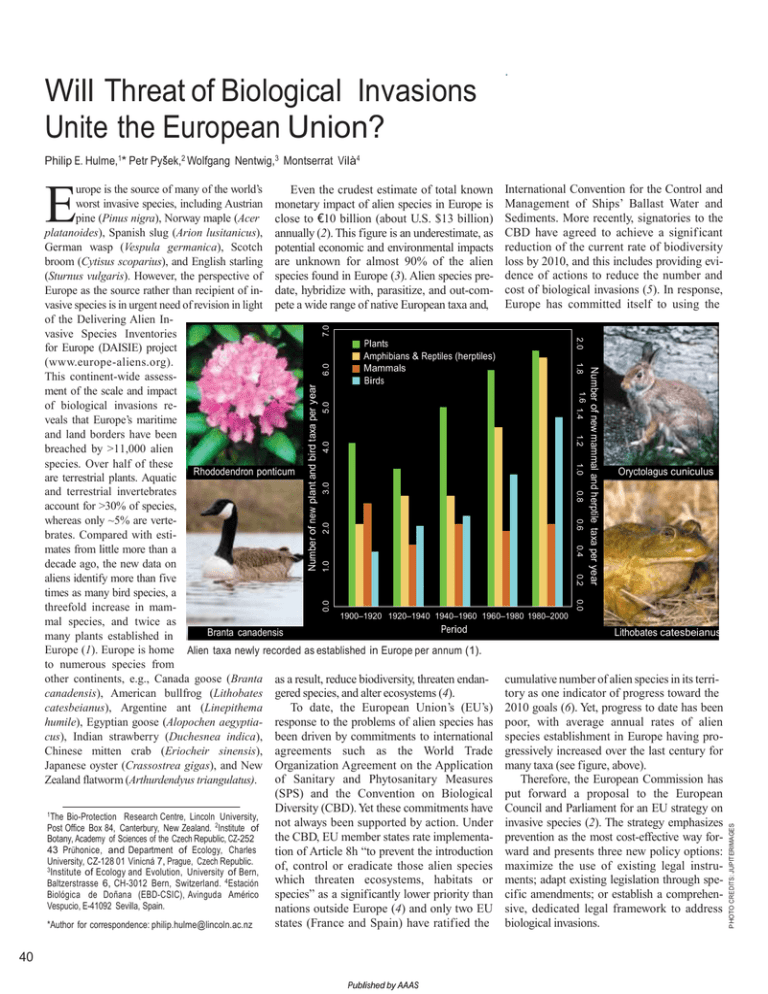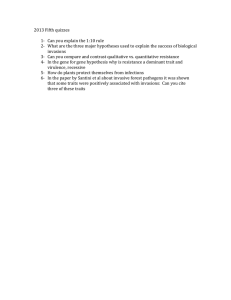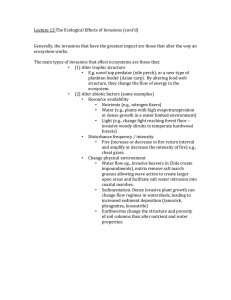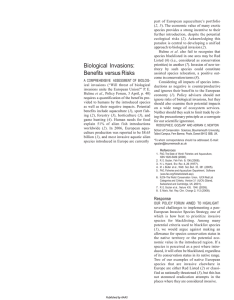science2009.doc
advertisement

. Will Threat of Biological Invasions Unite the European Union? Philip E. Hulme,1* Petr Pysek,2 Wolfgang Nentwig,3 Montserrat Vilà4 urope is the source of many of the world’s Even the crudest estimate of total known International Convention for the Control and worst invasive species, including Austrian monetary impact of alien species in Europe is Management of Ships’ Ballast Water and pine (Pinus nigra), Norway maple (Acer close to €10 billion (about U.S. $13 billion) Sediments. More recently, signatories to the platanoides), Spanish slug (Arion lusitanicus), annually (2). This figure is an underestimate, as CBD have agreed to achieve a signif icant German wasp (Vespula germanica), Scotch potential economic and environmental impacts reduction of the current rate of biodiversity broom (Cytisus scoparius), and English starling are unknown for almost 90% of the alien loss by 2010, and this includes providing evi(Sturnus vulgaris). However, the perspective of species found in Europe (3). Alien species pre- dence of actions to reduce the number and Europe as the source rather than recipient of in- date, hybridize with, parasitize, and out-com- cost of biological invasions (5). In response, vasive species is in urgent need of revision in light pete a wide range of native European taxa and, Europe has committed itself to using the of the Delivering Alien Invasive Species Inventories Plants for Europe (DAISIE) project Amphibians & Reptiles (herptiles) (www.europe-aliens.org). Mammals This continent-wide assessBirds ment of the scale and impact of biological invasions reveals that Europe’s maritime and land borders have been breached by >11,000 alien species. Over half of these Oryctolagus cuniculus are terrestrial plants. Aquatic Rhododendron ponticum and terrestrial invertebrates account for >30% of species, whereas only ~5% are vertebrates. Compared with estimates from little more than a decade ago, the new data on aliens identify more than five times as many bird species, a threefold increase in mam1900–1920 1920–1940 1940–1960 1960–1980 1980–2000 mal species, and twice as Period Branta canadensis Lithobates catesbeianus many plants established in Europe (1). Europe is home Alien taxa newly recorded as established in Europe per annum (1). to numerous species from other continents, e.g., Canada goose (Branta as a result, reduce biodiversity, threaten endan- cumulative number of alien species in its terricanadensis), American bullfrog (Lithobates gered species, and alter ecosystems (4). tory as one indicator of progress toward the catesbeianus), Argentine ant (Linepithema To date, the European Union’s (EU’s) 2010 goals (6). Yet, progress to date has been humile), Egyptian goose (Alopochen aegyptia- response to the problems of alien species has poor, with average annual rates of alien cus), Indian strawberry (Duchesnea indica), been driven by commitments to international species establishment in Europe having proChinese mitten crab (Eriocheir sinensis), agreements such as the World Trade gressively increased over the last century for Japanese oyster (Crassostrea gigas), and New Organization Agreement on the Application many taxa (see figure, above). of Sanitary and Phytosanitary Measures Therefore, the European Commission has Zealand flatworm (Arthurdendyus triangulatus). 7.0 E 2.0 6.0 5.0 4.0 1.2 0.8 3.0 1.0 2.0 0.6 1.0 0.4 0.2 0.0 0.0 *Author for correspondence: philip.hulme@lincoln.ac.nz 40 Published by AAAS put forward a proposal to the European Council and Parliament for an EU strategy on invasive species (2). The strategy emphasizes prevention as the most cost-effective way forward and presents three new policy options: maximize the use of existing legal instruments; adapt existing legislation through specific amendments; or establish a comprehensive, dedicated legal framework to address biological invasions. PHOTO CREDITS: JUPITERIMAGES Number of new plant and bird taxa per year 1.6 1.4 Bio-Protection Research Centre, Lincoln University, Post Office Box 84, Canterbury, New Zealand. 2Institute of Botany, Academy of Sciences of the Czech Republic, CZ-252 43 Prühonice, and Department of Ecology, Charles University, CZ-128 01 Vinicná 7, Prague, Czech Republic. 3Institute of Ecology and Evolution, University of Bern, Baltzerstrasse 6, CH-3012 Bern, Switzerland. 4Estación Biológica de Doñana (EBD-CSIC), Avinguda Américo Vespucio, E-41092 Sevilla, Spain. Number of new mammal and herptile taxa per year 1.8 1 The (SPS) and the Convention on Biological Diversity (CBD). Yet these commitments have not always been supported by action. Under the CBD, EU member states rate implementation of Article 8h “to prevent the introduction of, control or eradicate those alien species which threaten ecosystems, habitats or species” as a significantly lower priority than nations outside Europe (4) and only two EU states (France and Spain) have ratif ied the Current legislative efforts to prevent introduction of invasive alien species are most effective at targeting intentional releases or where liabilities can be readily determined, e.g., pests and pathogens on plant and animal products. However, recent introductions are increasingly unintentional (7). Major gaps exist in the binding international regulatory framework especially as relates to hull fouling, air transport, tourism, pets and aquarium and garden species, live bait and plant seeds, and interbasin water transfers and canals. One way that existing legislation could be adapted is through establishment of a “blacklist” of species prohibited from import and sale in Europe that would prioritize those species that pose the most significant threats. The EU has adopted such an approach in its Council Directive 2000/29/EC to protect against introduction and spread of organisms harmful to plants or plant products. This directive could form the basis for blacklisting a wider range of invasive pests in terrestrial and aquatic environments. Yet pan-European bodies have failed to agree on the criteria for listing species. The European and Mediterranean Plant Protection Organisation (EPPO) has listed several invasive plants as pests requiring official regulation because of their perceived threat to ecosystems and recommends its member countries take measures to prevent their introduction or spread and to manage established populations (8). Nevertheless, when EPPO risk assessments for several invasive plant species were submitted to the European Food Safety Authority (EFSA), the request to list them as official pests in Council Directive 2000/29/EC was declined (9, 10). Although EFSA acknowledged that the species were probably invasive, further quantitative information on population dynamics, environmental drivers, introduction pathways, spatial distribution, and impacts was required. Yet, such additional data may not reduce the uncertainty in assessing risks. As a result, lengthy and costly steps are likely to be necessary to officially blacklist even a single species. A further complication with blacklisting is that a significant proportion of alien species in Europe are native elsewhere on the continent— including half of all plants, a third of arthropods, and a quarter of the vertebrate species (1). A number of these European species include some of the worst aliens, e.g., Spanish slug, rabbit (Oryctolagus cuniculus), and rhododendron (Rhododendron ponticum). Blacklists may therefore need a regional or national focus. Several European countries have established their own national blacklists (2), but each uses different listing criteria based on qualitative expert opinion that do not match EFSA’s requirements and thus could be challenged. Legally binding blacklists supported by quantitative risk assessment may assist in the prevention of future threats, but current lists are reactive and include many species already established, often quite widely, in Europe (8). Although only ~10% of aliens established in Europe are known to have an economic or environmental impact, this still implies that there are >1000 species requiring proactive management (3). Europe does not have a particularly good record in managing alien species, with only 34 species (primarily vertebrates) successfully eradicated from one or more regions (11). Limited resources have often resulted in a piecemeal approach targeting local management, rather than a coordinated international effort. If Europe is serious about addressing biological invasions, and especially the 2010 target, then it should support establishment of an indicator that quantifies actual responses, e.g., number and cost of national management activities against invasive species (12). In contrast to prevention, the regulatory and technical tools addressing eradication, control, or management of invasive species remain poorly developed (13). Many of the policy and legislative needs identified for Europe are equally relevant to the U.S.A. where the Ecological Society of America has called for establishing a federal center to manage biological invasions that would parallel centers set up to tackle the threat of human diseases (14). Likewise, a new agency, the European Centre for Invasive Species Management (ECISM), could be established similarly to the European Centre for Disease Prevention and Control (ECDC) (15). ECISM would have a mission to identify, assess, and communicate current and emerging threats to the economy and environment posed by invasive species. It would bring together different elements relating to biological invasions that are currently dispersed among various European bodies, such as the European Environment Agency (monitoring and indicators), EFSA (risk assessment), and within different Directorates-General of the European Commission (environment, transport, agriculture, maritime affairs, and so on). ECISM would ensure a broader European perspective that better integrates regulatory, scientific, and public outreach initiatives, not only by addressing preventative measures, but also by rapid response and management. Responsibilities could include providing highlevel scientific advice, building a Europe-wide surveillance system, monitoring emerging threats in Europe to support rapid response, coordinating the European networking of bodies operating in the field of biological inva- sions, and communicating the scientific and technical outputs to stakeholders and the general public. ECISM would have no regulatory powers but would help develop new legislation addressing biological invasions. Would such a proposal appeal to the Council of Europe and European Parliament? The need for coordinated action has been expressed at the highest political levels in Europe (2). Under the Czech Presidency of the EU, addressing the European Commission proposal for an EU strategy on invasive species is seen as a priority (16). Yet there are challenges. The cornerstone of the EU is the single market and the regulatory environment has been designed to remove technical barriers to the free movement of goods and people (17). Yet levels of invasion in European countries are highly correlated with national Gross Domestic Products and reflect levels of external trade and capital investment (18). Politicians may view additional legislation and regulation to address biological invasions as an impediment to economic growth. Tax-payers may similarly be resistant to additional costs, especially because only 2% of the European public feel biological invasions are important threats to biodiversity (19). Results from DAISIE may help better inform such opinions and highlight the scale of the problem in Europe. Costs of a specific agency such as ECISM, if run on a budget similar to ECDC’s, would amount to <0.5% of the annual cost of biological invasions in Europe but could bring much greater dividends to the European economy and environment. References and Notes 1. DAISIE, Handbook of Alien Species in Europe (Springer, Dordrecht, 2009). 2. European Commission (EC), Towards an EU Strategy on Invasive Species [COM(2008) 789, EC, Brussels 2008]. 3. M. Vilà et al., Front. Ecol. Environ., 10.1890/080083, in press. 4. P. E. Hulme, Issues Environ. Sci. Technol. 25, 56 (2007). 5. A. Balmford et al., Science 307, 212 (2005). 6. European Environment Agency (EEA), Halting the Loss of Biodiversity by 2010: Proposal for a First Set of Indicators to Monitor Progress in Europe (EEA, Copenhagen, 2007). 7. P. E. Hulme et al., J. Appl. Ecol. 45, 403 (2008). 8. EPPO A2 List of dangerous plant pests recommended for regulation, www.eppo.org/QUARANTINE/listA2.htm. 9. EFSA Scientific Panel on Plant Health, EFSA J. 468, 1 (2007). 10. EFSA Scientific Panel on Plant Health, EFSA J. 539, 1 (2007). 11. P. Genovesi, Biol. Inv. 7, 127 (2005). 12. M. A. McGeoc et al., Conserv. Biol. 20, 1635 (2006). 13. P. E. Hulme, J. Appl. Ecol. 43, 835 (2006). 14. D. M. Lodge et al., Ecol. Appl. 16, 2035 (2006). 15. ECDC, http://ecdc.europa.eu. 16. Work Programme and Priorities of the Czech EU Presidency (Czech Presidency of the EU, Government of the Czech Republic); www.eu2009.cz/en. 17. European Communities, The Single Market for Goods (EC, Brussels, 2007); http://ec.europa.eu/enterprise/regulation/ goods/docs/single_mk_info_08/2007_5598_en.pdf. 18. P. E. Hulme, J. Appl. Ecol. 46, 10 (2009). 19. Gallup Organisation, Attitudes of Europeans Towards the Issue of Biodiversity (EC, Brussels 2007). 10.1126/science.1171111 41 Published by AAAS



